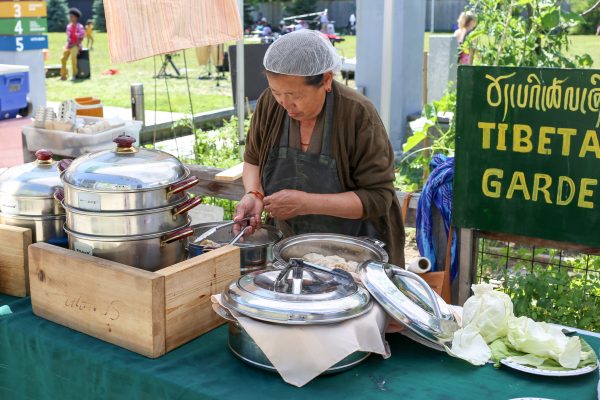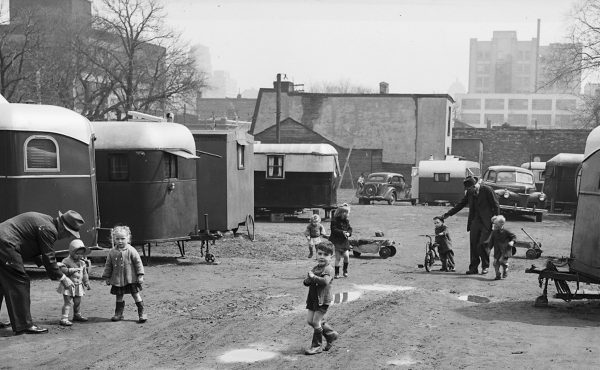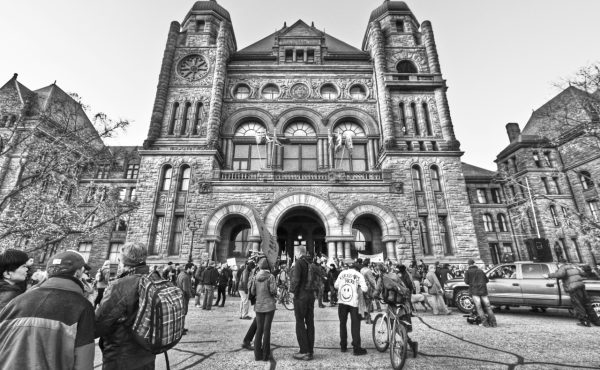The term “missing middle” has quickly become recognized as shorthand for housing that fills the gap between single family dwellings and high-rise living. But even before American architect Daniel Parolek coined the expression back in 2010, advocates seeking to preserve small and mid-sized farms in the U.S. were popularizing the idea of “agriculture of the middle” to describe the relentless growth of industrial-scale farming at the expense of family farms.
Here in Toronto, food expert Lori Stahlbrand, who has been advocating for better ways to connect fruit and produce grown by local mid-sized farmers with institutional purchasers (such as universities), distributors, farmers markets and consumers since the 1990s, saw an opportunity to expand the concept. In a 2006 research paper [PDF], she described “infrastructure of the middle” as the “hard and soft” parts of a more sustainable supply chain that could also “embrace fair trade and diaspora-based foods.”
This idea resonated with community builders like Marina Queirolo. In June last year, after a decade running the Evergreen Farmers Market at the Brickworks, Queirolo founded MarketCityTO, an emerging initiative dedicated to increasing the profile and effectiveness of public markets as an alternative to large multi-national grocery chains, which collectively account for as much as 80% of food dollars spent in Canada. Her goal is for public markets to “fill the mid-size distribution gap in food retailing in neighbourhoods throughout the city.”
While still with Evergreen, Queirolo earned a Master’s in Environmental Studies from York University, undertaking research that was both surprising and shocking.
“Everyone was stunned to find that there are more than 100 public markets of various types in Toronto,” she says. “What’s shocking – in a good way – is the incredible resilience of public markets throughout the pandemic. When lockdown happened, the large grocery chain stores were deemed ‘essential,’ but public markets, including farmers markets, weren’t. That put a lot of jobs and the livelihood of entrepreneurs throughout the food supply chain at risk.” It took a special effort from advocates like Queirolo, city staff and organizations like Farmers Markets Ontario to change that.
Queirolo’s research found that only a small percentage of these markets are permanent year-round institutions with paid staff. The majority rely heavily on hundreds of volunteers to keep seasonal and temporary markets functioning. Funding staff positions to support volunteers and a commitment to strategic investments in market buildings are issues that Queirolo is hopeful will be addressed later this year when the city brings forward a promised strategy that “embraces public markets as the missing middle in food retailing.”
The need for a common vision is urgent, Queirolo maintains. “There are currently four different city departments that regulate public markets! That is not only confusing but results in four different views on what’s important.”
“Public markets are carefully crafted places for commerce and trade, with an intentionally diverse range of locally owned and operated shops, stalls and day tables,” she continues. “But they also deliver many economic, social and environmental benefits, so they are perfect community development tools. That’s where MarketCityTO comes in. For now, our aim is to build a network, so market entrepreneurs can flourish but feel more supported and know they are part of a larger ecosystem.”
“Our mission is to make Toronto’s soul visible through its neighbourhood markets by building momentum to help politicians, entrepreneurs and the general public better understand the potential of public markets. Every neighbourhood should have one,” Queirolo insists. “Each market is unique, and reflects the make-up of the local population. But they are also treasured meeting places,” she says, adding that St Lawrence Market is one of the city’s most popular tourist attractions. “Developing a comprehensive city strategy could “increase the capacity of market entrepreneurs to advocate for the policies and resources they need to flourish.”
Public Markets as Vibrant Urban Spaces
Queirolo’s mission will take an important step forward this June when Toronto hosts the 11th International Public Markets Conference, organized by New York-based placemaking specialists, Project for Public Spaces. The event is co-hosted by Toronto’s economic development and culture division, St Lawrence Market and MarketCityTo.
Toronto won the right to stage the conference on its third attempt, having previously lost out to Barcelona and London. Michael Wolfson, the City’s food specialist, played a crucial role in landing the conference. The three-day event (June 8-10) will convene market managers, entrepreneurs, policymakers, academia, the private sector and politicians, combining keynote discussions with mobile workshops designed to uncover and celebrate local success stories. These include a collaboration between the city and Querirolo to pro-type new market models in Scarborough to provide better access to locally-produced, culturally-diverse fresh foods in underserved communities.
Queirolo also hopes that a scheduled tour of the Ontario Food Terminal during the conference will help mend fences with members of the local food community, who may not be aware of the vital role played by North America’s largest wholesale produce market in supplying locally produced fruit and vegetables to Toronto’s ‘main street’ grocery stores and many of the region’s independent grocers.
“The Terminal is the only wholesale market in North America with a government mandate to support local growers, catering to about 45% of Ontario’s 3,500 fruit and produce farmers, so it plays a vital role in supporting public markets and mid-sized retail food distribution infrastructure,” says Queirolo. “This isn’t well known, so we hope the conference can increase education and transparency across the ecosystem for the benefit of regulators and customers alike.”
Glenn Miller, FCIP is a senior associate with the Canadian Urban Institute. He was the principal author of CUI’s 2019 report, “The Ontario Food Terminal: A Priceless Hub in Ontario’s Food Value Chain,” prepared for the Golden Horseshoe Food and Farming Alliance with support from the City of Toronto. Register here for the June conference.




